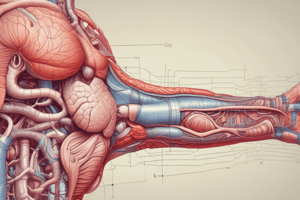Podcast
Questions and Answers
Which layer of the digestive tract wall contains Meissner's nerve plexuses?
Which layer of the digestive tract wall contains Meissner's nerve plexuses?
- Mucosa
- Submucosa (correct)
- Muscularis
- Serosa
What is the main function of the lamina propria?
What is the main function of the lamina propria?
- To provide mechanical support to the epithelial lining
- To richly supply blood vessels and lymphoid tissue (correct)
- To produce digestive enzymes
- To absorb nutrients from the digested food
What is the function of the circular and longitudinal smooth muscle in the muscularis layer?
What is the function of the circular and longitudinal smooth muscle in the muscularis layer?
- To absorb nutrients from the digested food
- To regulate blood flow to the digestive tract
- To propel food through the digestive tract (correct)
- To mix food with digestive enzymes
What is the term for the thin layer of loose connective tissue that covers the digestive tract?
What is the term for the thin layer of loose connective tissue that covers the digestive tract?
What type of epithelium covers the serosa?
What type of epithelium covers the serosa?
What is the term for the nerve plexus found in the muscularis layer?
What is the term for the nerve plexus found in the muscularis layer?
Flashcards are hidden until you start studying
Study Notes
Digestive System Structure
- Consists of two main parts: digestive tract and associated glands
- Digestive tract includes: oral cavity, mouth, esophagus, stomach, small intestine, large intestine, rectum, and anus
- Associated glands include: salivary glands, liver, pancreas, and gallbladder
Wall Structure of Digestive Tract
- Composed of four layers: mucosa, submucosa, muscularis, and serosa
Mucosa Layer
- Epithelial lining
- Lamina propria: loose connective tissue with blood vessels, lymphatic vessels, smooth muscle cells, glands, and lymphoid tissue
- Muscularis mucosae: circular and longitudinal smooth muscle cells
- Also known as mucous membrane
Submucosa Layer
- Dense connective tissue with many blood vessels, lymphatic vessels, and Meissner's nerve plexuses
Muscularis Layer
- Contains smooth muscle cells that are spirally oriented and divided into two layers: circular and longitudinal
- Contains Auerbach's nerve plexus, blood vessels, and connective tissue
Serosa Layer
- Thin layer of loose connective tissue rich in blood vessels, lymphatic vessels, adipose tissue, and simple squamous covering epithelium (mesothelium)
Studying That Suits You
Use AI to generate personalized quizzes and flashcards to suit your learning preferences.




